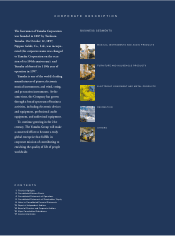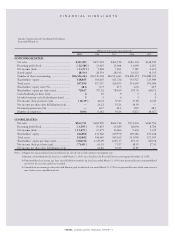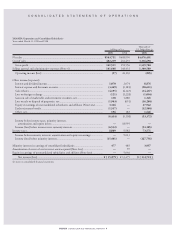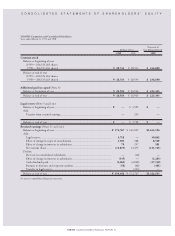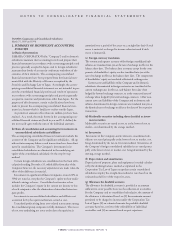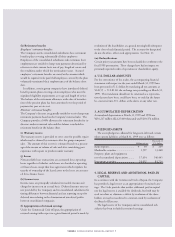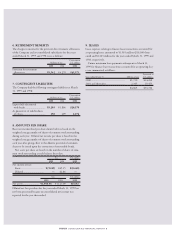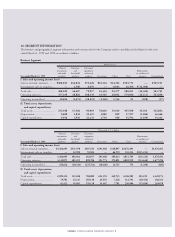Yamaha 1999 Annual Report Download - page 8
Download and view the complete annual report
Please find page 8 of the 1999 Yamaha annual report below. You can navigate through the pages in the report by either clicking on the pages listed below, or by using the keyword search tool below to find specific information within the annual report.
YAMAHA CONSOLIDATED FINANCIAL REPORT 6
1. SUMMARY OF SIGNIFICANT ACCOUNTING
POLICIES
(a) Basis of presentation
YAMAHA CORPORATION (the “Company”) and its domestic
subsidiaries maintain their accounting records and prepare their
financial statements in accordance with accounting principles and
practices generally accepted in Japan, and its foreign subsidiaries
maintain their books of account in conformity with those of the
countries of their domicile. The accompanying consolidated
financial statements have been prepared from the financial state-
ments filed with the Ministry of Finance as required by the
Securities and Exchange Law of Japan. Accordingly, the accom-
panying consolidated financial statements are not intended to pre-
sent the consolidated financial position and results of operations
in accordance with accounting principles and practices generally
accepted in countries and jurisdictions other than Japan. For the
purposes of this document, certain reclassifications have been
made to present the accompanying consolidated financial state-
ments in a format which is familiar to readers outside Japan.
As permitted, amounts of less than one million yen have been
omitted. As a result, the totals shown in the accompanying con-
solidated financial statements (both in yen and U.S. dollars) do
not necessarily agree with the sum of the individual amounts.
(b) Basis of consolidation and accounting for investments in
unconsolidated subsidiaries and affiliates
The accompanying consolidated financial statements include the
accounts of the Company and its significant subsidiaries. All sig-
nificant intercompany balances and transactions have been elimi-
nated in consolidation. The Company’s investments in its
consolidated subsidiaries are eliminated to the underlying net
equity of the consolidated subsidiaries by the step-by-step
method.
Certain foreign subsidiaries are consolidated on the basis of fis-
cal periods ending December 31, which differ from that of the
Company; however, the necessary adjustments are made when the
effect of the difference is material.
Investments in significant affiliates (companies owned 20% to
50%) are stated at cost plus the Company’s equity in their undis-
tributed earnings or losses. Consolidated net income or loss
includes the Company’s equity in the current net income or loss
of such companies, after the elimination of unrealized intercom-
pany profits.
Investments in unconsolidated subsidiaries and affiliates not
accounted for by the equity method are carried at cost.
Unrealized profit arising from asset-related transactions among
the consolidated group companies is fully eliminated. The excess
of cost over underlying net assets at the date of acquisition is
amortized over a period of five years on a straight-line basis if such
excess is material, or charged to income when incurred if such
excess is immaterial.
(c) Foreign currency translation
The revenue and expense accounts of the foreign consolidated sub-
sidiaries are translated into yen at the rate of exchange in effect at the
balance sheet date. The balance sheet accounts, except for the com-
ponents of shareholders’ equity, are also translated into yen at the
rate of exchange in effect at the balance sheet date. The components
of shareholders’ equity are translated at historical exchange rates.
Current assets and liabilities of the Company and its domestic
subsidiaries denominated in foreign currencies are translated at the
current exchange rates in effect at each balance sheet date if not
hedged by forward exchange contracts, or at the contracted rates of
exchange when hedged by forward exchange contracts. Other non-
current assets and liabilities of the Company and its domestic sub-
sidiaries denominated in foreign currencies are translated into yen at
the historical rates of exchange in effect at the dates of the respective
transactions.
(d) Marketable securities including those classified as invest-
ment securities
Marketable securities are stated at cost or at the lower of cost or
market, cost determined by the average method.
(e) Inventories
Inventories of the Company and its domestic consolidated sub-
sidiaries are stated principally at the lower of cost or market, cost
being determined by the last-in, first-out method. Inventories of
the Company’s foreign consolidated subsidiaries are stated princi-
pally at the lower of cost or market, cost being determined by the
moving average method.
(f ) Depreciation and amortization
Depreciation of property, plant and equipment is mainly calculat-
ed by the declining-balance method as stipulated in the
Corporation Tax Law of Japan except that certain consolidated
subsidiaries employ the straight-line method at rates based on the
estimated useful lives of the respective assets.
(g) Allowance for doubtful accounts
The allowance for doubtful accounts is provided at an amount
sufficient to cover possible losses on the collection of receivables.
For the Company and its consolidated subsidiaries, the amount of
the allowance is determined based on (1) the maximum amount
permitted to be charged to income under the Corporation Tax
Law of Japan, (2) an estimated amount for probable doubtful
accounts based on a review of the collectibility of individual
receivables, and (3) an amount based on past experience.
NOTES TO CONSOLIDATED FINANCIAL STATEMENTS
YAMAHA Corporation and Consolidated Subsidiaries
March 31, 1999 and 1998


